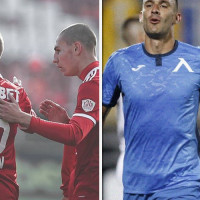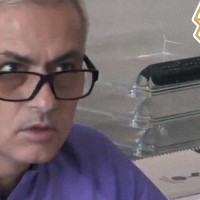The basis of success of any football manager is the choice in tactics. Most decide to stick to what they already know but few mavericks of the game end up becoming true innovators thanks to their creative minds and fearless natures.
Louis van Gaal - Ajax
Van Gaal and his dutch side of youngsters developed from the ranks of the famous Ajax academy managed to win the Champions League playing 3-3-1-3 (or 3-1-3-3). It was enigma to some and like all great works of art it was open for interpretation. With that formation LVG was able to showcase the world what he was cooking in the years prior to his perfect Champions League season where he won the trophy without a single loss.
.jpg)
Guus Hiddink - Australia
Another Dutchman to be included in our list is Guus Hiddink who it 2006 was in charge of Australia when they appeared at thet year’s World Cup held in Germany. That was their first appearance in 32 years and thanks to the 3-6-1 employed by the dutch mastermind they managed to progress from the group stage and reach the elimination round where they lost to Italy with a controversial penalty. Thanks to the enforced midfield the “kangaroos” had most of the possession in their WC games. Stats show that they had the ball 56% of the time against Japan, 58% against Croatia and even 55% versus Italy.
.jpg)
Pep Guardiola- Barcelona
The 4-2-4 used by Barcelona’s most beloved son was used mostly throughout the 2009/2010 campaign. The Spaniards often start in a 4-4-3, but when in possession they do transition to a 4-2-4. The drawback to playing this is that midfield is often left barren and it is hard for players to regroup after losing the ball.
.jpg)
Vicente del Bosque - Spain
In 2012 the Spanish national side won the Euro with a 4-6-0 employed by the then coach Vicente del Bosque. The key to the whole strategy was the false nine position which was entrusted to Cesc Fabregas while no real striker was used. The general idea was for Cesc to drop deep in midfield which leaves spaces for players such as Iniesta and David Silva who would use them to score or create chances.
.jpg)
Pep Guardiola - Bayern Munich
Guardiola strikes again. At Bayern, his latest managerial masterstroke had been the dawning of the 3-4-3 at the Allianz Arena. Recognising that Bayern had sufficient ammunition and tactical nous to inhabit such a system, Guardiola tweaked the system of his predecessor, Jupp Heynckes, and to great effect.The Catalonian tactician made use of Bayern’s tremendous squad depth. Following a mounting injury list which included Javi Martinez and Bastian Schweinsteiger, Guardiola transformed Philippe Lahm into a meticulous deep-lying midfielder.Lahm proved to be an outstanding deputy in midfield and Bayern were rampant in the Bundesliga once again, clinching the title in record time on matchday 27, ending up with a winning margin of 19 points.
.jpg)
Marcelo Bielsa - Chile
Another intriguing tactical innovation at the 2010 World Cup was Marcelo Bielsa’s attack-minded 3-3-1-3 with Chile. The eccentric coach has always possessed a fascinating tactical artillery and he used it in South Africa as his Chile side garnered many plaudits for their endeavour and bold style of play.He had four defensively minded players in his side, the back three and the holding midfielder. He then had two wing-backs who surged forward energetically, adding pace and penetration to the Chilean attacks.The idea behind Bielsa’s system at Chile was to press high and aggressively and stretch the play whenever possible. The system let players such as Alexis Sanchez and Arturo Vidal come to prominence and announce themselves as two of the world’s most talented footballers.Under the 3-3-1-3, Bielsa and Chile left the 2010 World Cup with their heads held high after valiantly bowing out at the last-16 stage following a defeat to Brazil.
.jpg)
Michel Hidalgo - France
This was Les Blues’ fabled ‘Magic Square’ formation which is widely acknowledged as one of the greatest midfields in footballing history. Coach Michel Hidalgo constructed a midfield of supreme creativity, muscle and technique with the quartet of Jean Tigana, Alain Giresse, Spanish-born Luis Fernandez and the magnificent Michel Platini.With Fernandez occupying the holding role, Tigana, Platini and Giresse all had license to roam and display their remarkable playmaking qualities. Tigana would regularly drop in beside Fernandez to ensure France’s back four were receiving sufficient cover.Working wonderfully in tandem, the talented quartet acted as both the engine room and creative hub of the triumphant France side. Platini, operating at the peak of his powers, scored a stunning 9 goals in 5 games to help propel his nation to European glory.
.jpg)
Honorable mention: Hristo Stoichkov - Bulgaria
In 2004 despite having little to no managerial experience and cruising solely on his image as a legendary player, Hristo Stoichkov was hired to try and lead Bulgaria to the World Cup finals in Germany. In a game against Malta Hristo deployed a very unusual 2-3-5 which sometimes even looked like 2-0-8.
The tactical set up left the Bulgarians shaky in defense which was exploited by a Maltese counter attack that saw the team from the tiny island nation take the lead. Fortunately at that point in time Bulgaria boasted great attacking prowess in its ranks with the likes of Dimitar Berbatov, Martin Petrov and Valeri Bojinov.
Eventually the Bulgarians equalized trough Berba, but admittedly it took them way too long to get the goal. It was scored just a minute before half time.
In the second half the Slavs scored another three and the final scoreline of 4:1 is confirmed.
After the game Stoichkov said that he was always confident that his boys were going to win but never again used that 2-3-5. A few years later as a manager of Celta Vigo he famously proclaimed: “I don’t really believe in tactics.”
.jpg)































buying viagra online in australia various kinds of viagra generic viagra [urlhttp:genqpviag.com]viagra in los angeles[url] ’
Отговори 0 0